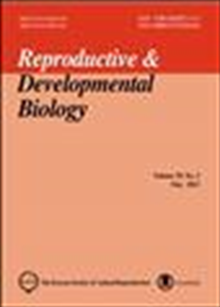간행물
Reproductive & developmental biology

- 발행기관 한국동물번식학회
- 자료유형 학술지
- 간기 계간
- ISSN 1738-2432 (Print)2288-0151 (Online)
- 수록기간 1977 ~ 2018
- 주제분류 농수해양 > 축산학 농수해양 분류의 다른 간행물
- 십진분류KDC 527DDC 636
권호리스트/논문검색
Volume 39 No 2 (2015년 5월) 4건
1.
2015.05
구독 인증기관·개인회원 무료
2.
2015.05
구독 인증기관 무료, 개인회원 유료
Pigs are considered an ideal source of human disease model due to their physiological similarities to humans. However, the low efficiency of in vitro embryo production (IVP) is still a major barrier in the production of pig offspring with gene manipulation. Despite ongoing advances in the associated technologies, the developmental capacity of IVP pig embryos is still lower than that of their in vivo counterparts, as well as IVP embryos of other species (e.g., cattle and mice). The efficiency of IVP can be influenced by many factors that affect various critical steps in the process. The previous relevant reviews have focused on the in vitro maturation system, in vitro culture conditions, in vitro fertilization medium, issues with polyspermy, the utilized technologies, etc. In this review, we concentrate on factors that have not been fully detailed in prior reviews, such as the oocyte morphology, oocyte recovery methods, denuding procedures, first polar body morphology and embryo quality.
4,000원
3.
2015.05
구독 인증기관 무료, 개인회원 유료
The oocyte undergoes various events during maturation and requires many substances for the maturation process. Various intracellular organelles are also involved in maturation of the oocyte. During the process glucose is essential for nuclear and cytoplasmic maturation, and adenosine triphosphate is needed for reorganization of the organelles and cytoskeleton. If mitochondrial function is lost, several developmental defects in meiotic chromosome segregation and maturation cause fertilization failure. The endoplasmic reticulum, a store for Ca2+, releases Ca2+ into the cytoplasm in response to various cellular signaling molecules. This event stimulates secretion of hormones, growth factors and antioxidants in oocyte during maturation. Also, oocyte nuclear maturation is stimulated by growth factors such as epidermal growth factor. This review summarizes roles of organelles with focus on the Golgi apparatus during maturation in oocyte.
4,000원
4.
2015.05
구독 인증기관·개인회원 무료
Sirtuin proteins are evolutionary conserved Sir2-related NAD+-dependent deacetylases and regulate many of cellular processes such as metabolism, inflammation, transcription, and aging. Sirtuin contains activity of either ADP-ribosyl-transferase or deacetyltranfease and their activity is dependent on the localization in cells. However, the expression pattern of Sirtuins has not been well studied. To examine the expression levels of Sirtuins, RT-PCR was performed using total RNAs from various tissues including liver, small intestine, heart, brain, kidney, lung, spleen, stomach, uterus, ovary, and testis. Sirtuins were highly expressed in most of tissues including the testis. Immunostaining assay showed that Sirt1 and Sirt6 were mainly located in the nucleus of germ cells, spermatocytes, and spermatids in the seminiferous tubules, whereas Sirt2 and Sirt5 were exclusively present in the cytoplasm of germ cells and sperma-tocytes. Our results indicate that Sirtuins may function as regulators of spermatogenesis and their activities might be dependent on their location in the seminiferous tubules.

